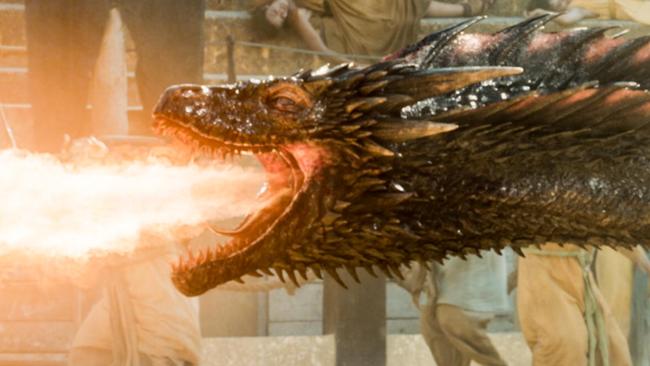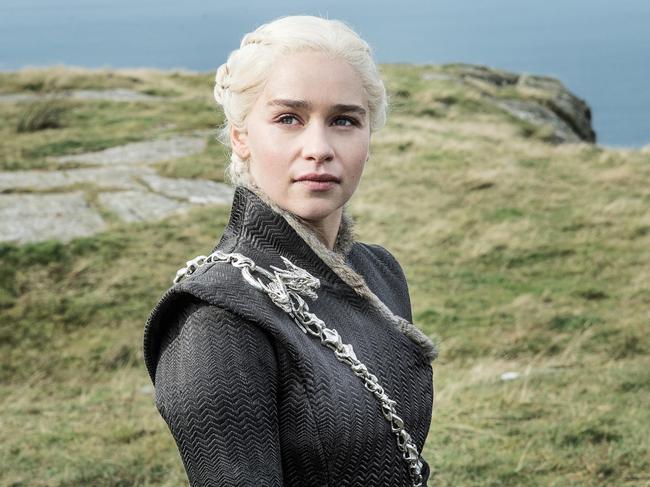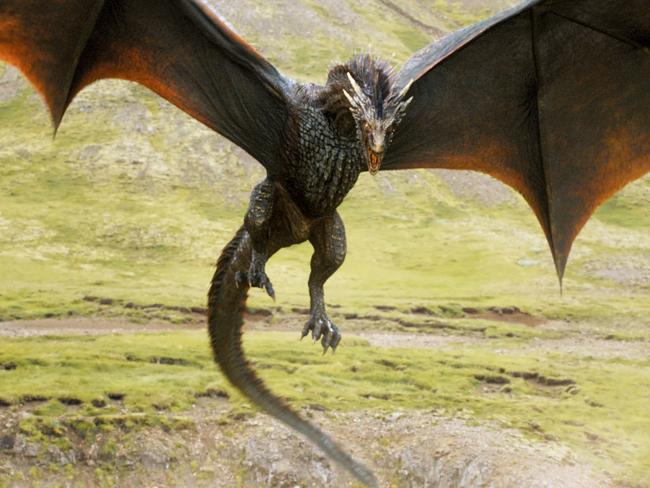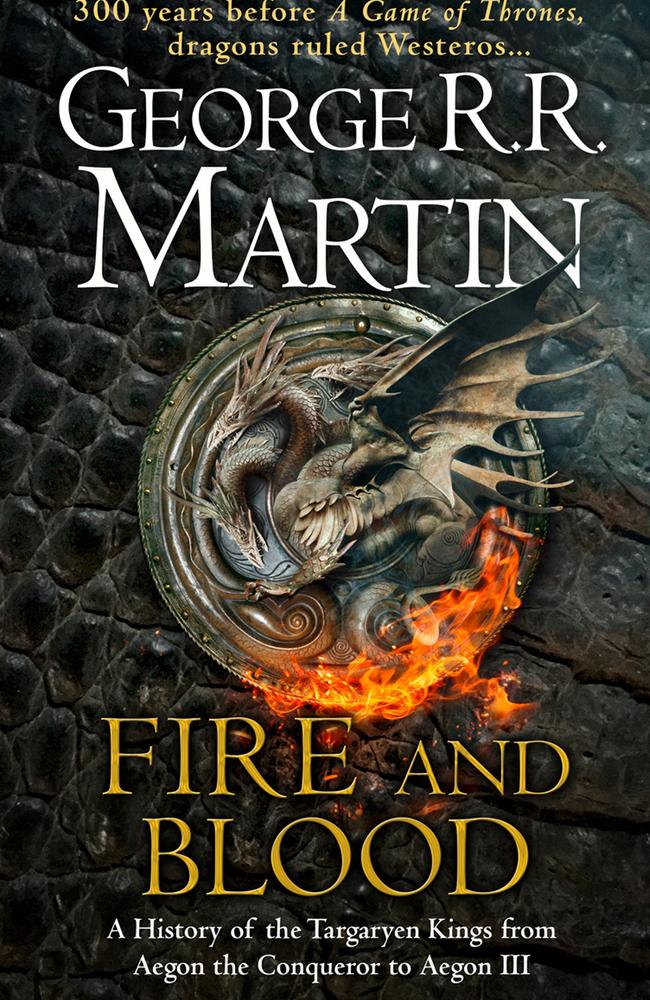Extract from George R.R. Martin’s new fantasy novel, Fire and Blood
Hundreds of years before the events in Game of Thrones, the dragons were a devastating force, as this exclusive early extract of George R.R. Martin’s fantasy epic Fire and Blood reveals.

Books
Don't miss out on the headlines from Books. Followed categories will be added to My News.
House Targaryen had ruled Dragonstone for more than two hundred years, since Lord Aenar Targaryen first arrived from Valyria with his dragons. Though it had always been their custom to wed brother to sister and cousin to cousin, young blood runs hot, and it was not unknown for men of the house to seek their pleasures amongst the daughters (and even the wives) of their subjects, the smallfolk who lived in the villages below the Dragonmont, tillers of the land and fishers of the sea. Indeed, until the reign of King Jaehaerys, the ancient right to the first night had been invoked mayhaps more oft on Dragonstone than anywhere else in the Seven Kingdoms, though Good Queen Alysanne would surely have been shocked to hear it.
Though the first night was greatly resented elsewhere, as Queen Alysanne had learned in her women’s counsels, such feelings were muted upon Dragonstone, where Targaryens were rightly regarded as being closer to gods than the common run of men. Here, brides thus blessed upon their wedding nights were envied, and the children born of such unions were esteemed above all others, for the Lords of Dragonstone oft celebrated the birth of such with lavish gifts of gold and silk and land to the mother. These happy bastards were said to have been “born of dragonseed,” and in time became known simply as “seeds.” Even after the end of the right of the first night, certain Targaryens continued to dally with the daughters of innkeeps and the wives of fishermen, so seeds and the sons of seeds were plentiful on Dragonstone.
It was to them that Prince Jacaerys turned, at the urging of his fool, vowing that any man who could master a dragon would be granted lands and riches and dubbed a knight. His sons would be ennobled, his daughters wed to lords, and he himself would have the honour of fighting beside the Prince of Dragonstone against the pretender Aegon II Targaryen and his treasonous supporters.
Not all those who came forward in answer to the prince’s call were seeds, nor even the sons or grandsons of seeds. A score of the queen’s own household knights offered themselves as dragonriders, amongst them the Lord Commander of her Queensguard, Ser Steffon Darklyn, along with squires, scullions, sailors, men-at-arms, mummers, and two maids. “The Sowing of the Seeds,” Munkun names the triumphs and tragedies that ensued (crediting the notion to Jacaerys himself, not Mushroom). Others prefer “the Red Sowing.”

The most unlikely of these would-be dragonriders was Mushroom himself, whose Testimony speaks at length of his attempt to mount old Silverwing, judged to be the most docile of the masterless dragons. One of the dwarf ’s more amusing tales, it ends with Mushroom running across the ward of Dragonstone with the seat of his pantaloons on fire, and nigh drowning when he leapt into a well to quench the flames. Unlikely, to be sure … but it does provide a droll moment in what was otherwise a ghastly business.
Dragons are not horses. They do not easily accept men upon their backs, and when angered or threatened, they attack. Munkun’s True Telling tells us that sixteen men lost their lives during the Sowing. Three times that number were burned or maimed. Steffon Darklyn was burned to death whilst attempting to mount the dragon Seasmoke. Lord Gormon Massey suffered the same fate when approaching Vermithor. A man called Silver Denys, whose hair and eyes lent credence to his claim to be descended from a bastard son of Maegor the Cruel, had an arm torn off by Sheepstealer. As his sons struggled to staunch the wound, the Cannibal descended on them, drove off Sheepstealer, and devoured father and sons alike.
Yet Seasmoke, Vermithor, and Silverwing were accustomed to men and tolerant of their presence. Having once been ridden, they were more accepting of new riders. Vermithor, the Old King’s own dragon, bent his neck to a blacksmith’s bastard, a towering man called Hugh the Hammer or Hard Hugh, whilst a pale-haired man-at-arms named Ulf the White (for his hair) or Ulf the Sot (for his drinking) mounted Silverwing, beloved of Good Queen Alysanne. And Seasmoke, who had once borne Laenor Velaryon, took onto his back a boy of ten-and-five known as Addam of Hull, whose origins remain a matter of dispute amongst historians to this day.

Addam and his brother, Alyn (one year younger), had been born to a woman named Marilda, the pretty young daughter of a shipwright. A familiar sight about her father’s shipyards, the girl was better known as Mouse, for she was “small, quick, and always underfoot.” She was still sixteen when she gave birth to Addam in 114 AC, and barely eighteen when Alyn followed in 115. Small and quick as their mother, these bastards of Hull were both silver of hair and purple of eye, and soon proved to have “sea salt in their blood” as well, growing up in their grandsire’s shipyard and going to sea as ship’s boys before the age of eight. When Addam was ten and Alyn nine, their mother inherited the yards upon her own father’s death, sold them, and used the coin to take to the sea herself as the mistress of a trading cog she named Mouse. A canny trader and daring captain, by 130 AC Marilda of Hull owned seven ships, and her bastard sons were always serving on one or the other.
That Addam and Alyn were dragonseed no man who looked upon them could doubt, though their mother steadfastly refused to name their father. Only when Prince Jacaerys put out the call for new dragonriders did Marilda at last break her silence, claiming both boys were the natural sons of the late Ser Laenor Velaryon.
They had his look, it was true, and Ser Laenor had been known to visit the shipyard in Hull from time to time. Nonetheless, many on Dragonstone and Driftmark were sceptical of Marilda’s claim, for Laenor Velaryon’s disinterest in women was well remembered. None dared name her liar, however … for it was Laenor’s own father, Lord Corlys himself, who brought the boys to Prince Jacaerys for the Sowing. Having outlived all of his children and suffered the betrayal of his nephews and cousins, the Sea Snake seemed more than eager to accept these newfound grandsons. And when Addam of Hull mounted Ser Laenor’s dragon, Seasmoke, it seemed to prove the truth of his mother’s claims.
It should not surprise us, therefore, that Grand Maester Munkun and Septon Eustace both dutifully assert Ser Laenor’s parentage … but Mushroom, as ever, dissents. In his Testimony, the fool puts forth the notion that “the little mice” had been sired not by the Sea Snake’s son, but by the Sea Snake himself. Lord Corlys did not share Ser Laenor’s erotic predispositions, he points out, and the Hull shipyards were like unto a second home to him, whereas his son visited them less frequently. Princess Rhaenys, his wife, had the fiery temperament of many Targaryens, Mushroom says, and would not have taken kindly to her lord husband fathering bastards on a girl half her age, and a shipwright’s daughter besides. Therefore his lordship had prudently ended his “shipyard trysts” with Mouse after Alyn’s birth, commanding her to keep her boys far from court. Only after the death of Princess Rhaenys did Lord Corlys at last feel able to bring his bastards safely forward.

In this instance, it must be said, the tale told by the fool seems more likely than the versions offered by septon and maester. Many and more at Queen Rhaenyra’s court must surely have suspected the same. If so, they held their tongues. Not long after Addam of Hull had proved himself by flying Seasmoke, Lord Corlys went so far as to petition Queen Rhaenyra to remove the taint of bastardy from him and his brother. When Prince Jacaerys added his voice to the request, the queen complied. Addam of Hull, dragonseed and bastard, became Addam Velaryon, heir to Driftmark.
Yet that did not write an end to the Red Sowing. More, and worse, was yet to come, with dire consequences for the Seven Kingdoms.
Dragonstone’s three wild dragons were less easily claimed than those that had known previous riders, yet attempts were made upon them all the same. Sheepstealer, a notably ugly “mud brown” dragon hatched when the Old King was still young, had a taste for mutton, swooping down on shepherd’s flocks from Driftmark to the Wendwater. He seldom harmed the shepherds, unless they attempted to interfere with him, but had been known to devour the occasional sheep dog. Grey Ghost dwelt in a smoking vent high on the eastern side of the Dragonmont, preferred fish, and was most oft glimpsed flying low over the narrow sea, snatching prey from the waters. A pale grey-white beast, the colour of morning mist, he was a notably shy dragon who avoided men and their works for years at a time.
The largest and oldest of the wild dragons was the Cannibal, so named because he had been known to feed on the carcasses of dead dragons, and descend upon the hatcheries of Dragonstone to gorge himself on newborn hatchlings and eggs. Coal black, with baleful green eyes, the Cannibal had made his lair on Dragonstone even before the coming of the Targaryens, some smallfolk claimed. (Grand Maester Munkun and Septon Barth both found this story most unlikely, as do I.) Would-be dragontamers had made attempts to ride him a dozen times; his lair was littered with their bones.
None of the dragonseeds were fool enough to disturb the Cannibal (any who were did not return to tell their tales). Some sought the Grey Ghost, but could not find him, for he was ever an elusive creature. Sheepstealer proved easier to flush out, but he remained a vicious, ill-tempered beast, who killed more seeds than the three castle dragons together. One who hoped to tame him (after his quest for Grey Ghost proved fruitless) was Alyn of Hull. Sheepstealer would have none of him. When he stumbled from the dragon’s lair with his cloak aflame, only his brother’s swift action saved his life. Seasmoke drove the wild dragon off as Addam used his own cloak to beat out the flames. Alyn Velaryon would carry the scars
of the encounter on his back and legs for the rest of his long life. Yet he counted himself fortunate, for he lived. Many of the other seeds and seekers who aspired to ride upon Sheepstealer’s back ended in Sheepstealer’s belly instead.
In the end, the brown dragon was brought to heel by the cunning and persistence of a “small brown girl” of six-and-ten, who delivered him a freshly slaughtered sheep every morning, until Sheepstealer learned to accept and expect her. Munkun sets down the name of this unlikely dragonrider as Nettles. Mushroom tells us the girl was a bastard of uncertain birth called Netty, born to a dockside whore. By any name, she was black-haired, brown-eyed, brown-skinned, skinny, foul-mouthed, fearless … and the first and last rider of the dragon Sheepstealer.

Thus did Prince Jacaerys achieve his goal. For all the death and pain it caused, the widows left behind, the burned men who would carry their scars until the day they died, four new dragonriders had been found. As 129 AC drew to a close, the prince prepared to fly against King’s Landing. The date he chose for the attack was the first full moon of the new year.
Yet the plans of men are but playthings to the gods. For even as Jace laid his plans, a new threat was closing from the east. The schemes of Otto Hightower had borne fruit; meeting in Tyrosh, the High Council of the Triarchy had accepted his offer of alliance. Ninety warships swept from the Stepstones under the banners of the Three Daughters, bending their oars for the Gullet … and as chance and the gods would have it, the Pentoshi cog Gay Abandon, carrying two Targaryen princes, sailed straight into their teeth.
The escorts sent to protect the cog were sunk or taken; the Gay Abandon captured. The tale reached Dragonstone only when Prince Aegon arrived desperately clinging to the neck of his dragon, Stormcloud. The boy was white with terror, Mushroom tells us, shaking like a leaf and stinking of piss. Only nine, he had never flown before … and would never fly again, for Stormcloud had been terribly wounded as he fled the Gay Abandon, arriving with the stubs of countless arrows embedded in his belly, and a scorpion bolt through his neck. He died within the hour, hissing as the hot blood gushed black and smoking from his wounds.
Aegon’s younger brother, Prince Viserys, had no way of escaping from the cog. A clever boy, he hid his dragon’s egg and changed into ragged, salt-stained clothing, pretending to be no more than a common ship’s boy, but one of the real ship’s boys betrayed him, and he was made a captive. It was a Tyroshi captain who first realized whom he had, Munkun writes, but the admiral of the fleet, Sharako Lohar of Lys, soon relieved him of his prize.
The Lysene admiral divided his fleet for the attack. One pincer was to enter the Gullet south of Dragonstone, the other to the north. In the early morning hours of the fifth day of the 130th year since Aegon’s Conquest, battle was joined. Sharako’s warships swept in with the rising sun behind them. Hidden by the glare, they took many of Lord Velaryon’s galleys unawares, ramming some and swarming aboard others with ropes and grapnels. Leaving Dragonstone unmolested, the southern squadron fell upon the shores of Driftmark, landing men at Spicetown and sending fire ships into the harbour to set ablaze the ships coming out to meet them. By mid-morning Spicetown was burning, whilst Myrish and Tyroshi troops battered at the very doors of High Tide.

When Prince Jacaerys swept down upon a line of Lysene galleys on Vermax, a rain of spears and arrows rose up to meet him. The sailors of the Triarchy had faced dragons before whilst warring against Prince Daemon in the Stepstones. No man could fault their courage; they were prepared to meet dragonflame with such weapons as they had. “Kill the rider and the dragon will depart,” their captains and commanders had told them. One ship took fire, and then another. Still the men of the Free Cities fought on … until a shout rang out, and they looked up to see more winged shapes coming around the Dragonmont and turning toward them.
It is one thing to face a dragon, another to face five. As Silverwing, Sheepstealer, Seasmoke, and Vermithor descended upon them, the men of the Triarchy felt their courage desert them. The line of warships shattered, as one galley after another turned away. The dragons fell like thunderbolts, spitting balls of fire, blue and orange, red and gold, each brighter than the next. Ship after ship burst asunder or was consumed by flames. Screaming men leapt into the sea, shrouded in fire. Tall columns of black smoke rose up from the water. All seemed lost … all was lost …
Several differing tales were told afterward of how and why the dragon fell. Some claimed a crossbowman put an iron bolt through his eye, but this version seems suspiciously similar to the way Meraxes met her end, long ago in Dorne. Another account tells us that a sailor in the crow’s nest of a Myrish galley cast a grapnel as Vermax was swooping through the fleet. One of its prongs found purchase between two scales, and was driven deep by the dragon’s own considerable speed. The sailor had coiled his end of the chain about the mast, and the weight of the ship and the power of Vermax’s wings tore a long jagged gash in the dragon’s belly. The dragon’s shriek of rage was heard as far off as Spicetown, even through the clangour of battle. His flight jerked to a violent end, Vermax went down smoking and screaming, clawing at the water. Survivors said he struggled to rise, only to crash headlong into a burning galley. Wood splintered, the mast came tumbling down, and the dragon, thrashing, became entangled in the rigging. When the ship heeled over and sank, Vermax sank with her.
It is said that Jacaerys Velaryon leapt free and clung to a piece of smoking wreckage for a few heartbeats, until some crossbowmen on the nearest Myrish ship began loosing quarrels at him. The prince was struck once, and then again. More and more Myrmen brought crossbows to bear. Finally one quarrel took him through the neck, and Jace was swallowed by the sea.
The Battle in the Gullet raged into the night north and south of Dragonstone, and remains amongst the bloodiest sea battles in all of history. Sharako Lohar had taken a combined fleet of ninety Myrish, Lyseni, and Tyroshi warships from the Stepstones; twenty-eight survived to limp home, all but three crewed by Lyseni. In the aftermath, the widows of Myr and Tyrosh accused the admiral of sending their fleets to destruction whilst holding back his own, beginning the quarrel that would spell the end of the Triarchy two years later, when the three cities turned against each other in the Daughters’ War. But that is outside the scope of this tale.

Though the attackers bypassed Dragonstone, no doubt believing that the ancient Targaryen stronghold was too strong to assault, they exacted a grievous toll on Driftmark. Spicetown was brutally sacked, the bodies of men, women, and children butchered in the streets and left as fodder for gulls and rats and carrion crows, its buildings burned. The town would never be rebuilt. High Tide was put to the torch as well. All the treasures the Sea Snake had brought back from the east were consumed by fire, his servants cut down as they tried to flee the flames. The Velaryon fleet lost almost a third of its strength. Thousands died. Yet none of these losses were felt so deeply as that of Jacaerys Velaryon, Prince of Dragonstone and heir to the Iron Throne.
Rhaenyra’s youngest son seemed lost as well. In the confusion of battle, none of the survivors seemed quite certain which ship Prince Viserys had been on. Men on both sides presumed him dead, drowned or burned or butchered. And though his brother Aegon the Younger had fled and lived, all the joy had gone out of the boy; he would never forgive himself for leaping onto Stormcloud and abandoning his little brother to the enemy. It is written that when the Sea Snake was congratulated on his victory, the old man said, “If this be victory, I pray I never win another.”
Mushroom tells us there were two men on Dragonstone that night who drank to the slaughter in a smoky tavern beneath the castle: the dragonriders Hugh the Hammer and Ulf the White, who had flown Vermithor and Silverwing into battle and lived to boast of it. “We are knights now, truly,” Hard Hugh declared. And Ulf laughed and said, “Fie on that. We should be lords.”
The girl Nettles did not share their celebrations. She had flown with the others, fought as bravely, burned and killed as they had, but her face was black with smoke and streaked with tears when she returned to Dragonstone. And Addam Velaryon, lately Addam of Hull, sought out the Sea Snake after the battle; what they spoke to each other even Mushroom does not say.
Edited extract from Fire and Blood, by George R.R. Martin
Published by HarperCollins Australia, out November 20.


